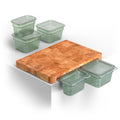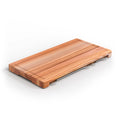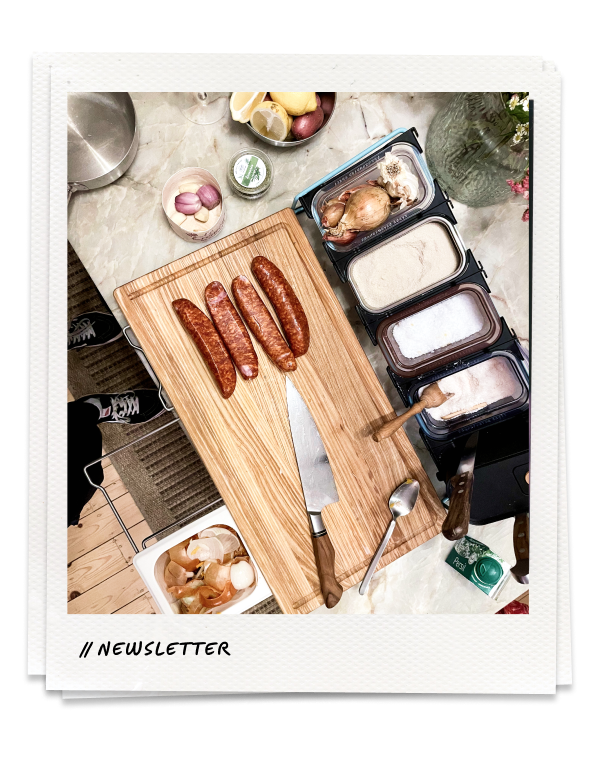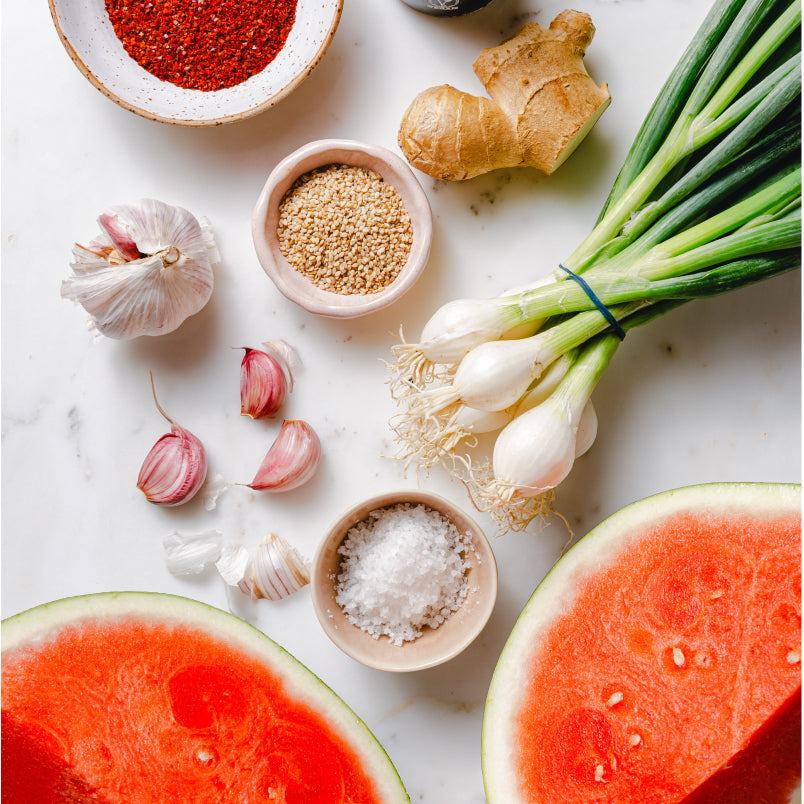HOW TO: CLEANING
At first glance, the Frankfurt board (no matter which model) looks much more complicated than it is – and the same applies to cleaning it.
The container system can also be used for cleaning, which offers a tangible advantage in everyday cleaning:
A container is filled with soapy water, leftover food on the board is thrown into the attached waste container and the board is thoroughly scrubbed right there - excess soapy water also goes into the waste container after scrubbing.
This means you no longer have to carry the board to the sink to clean it. Over time, this new cleaning routine becomes second nature and is simply fun compared to cleaning regular cutting boards in sinks that are too small.
Here is the procedure in detail, step by step:
01. The daily portion of love – cleaning after cooking
1) EMPTY BOARD:
Once the board is assembled, throw leftover food/garbage etc. into the waste container that is still attached.
2) SCRUBBING:
Scrub the board thoroughly with hot water and plenty of soap using a scouring pad. Then use the sponge to throw the dirty soapy water into the attached waste container.
3) DISMANTLE:
Remove all remaining containers, place waste in trash cans, and place/wash containers in the dishwasher.
4) DRYING:
Thoroughly dry the board with a kitchen towel, remove the front bracket if necessary and put it in the dishwasher as well - but it is usually sufficient to just wash the brackets briefly with soap and dry them.
5) TURN REGULARLY
To prevent irregular wear, please turn the board regularly and use it as evenly as possible.
(Exception: BASIC - here only one side can be used. If this side is heavily worn, see below)
02 PRO TIP: PEELING FOR THE BOARD
Sometimes the board absorbs odors for a short time - especially garlic or onions.
Here, a simple household remedy can help, which provides short-term relief (odours usually disappear on their own after a few days):
1) PEELING PASTE:
Make a creamy paste from the juice of a fresh lemon and regular salt directly on the board in the affected area.
2) SCRUBBING AS FAR AS YOU CAN:
Spread the paste over the affected areas with a scouring pad (usually the front third of the work area) and scrub VIGOROUSLY. This procedure actually has a similar effect to a peeling: the top layer of the board is lightly sanded and deposits are removed, and the lemon juice also neutralizes odors.
3) LET IT DRY:
Allow to dry overnight, then a layer of oil is recommended for the damaged wood.
Basically , wooden boards are more hygienic than plastic boards ( here is our article on the subject ), but foods such as raw meat or fish must be classified as potentially dangerous foods, even in private kitchens, and should be strictly separated from vegetables and fruit.
To process meat (or chili and garlic), we always recommend using our interfaces (link here ), which can then simply be put in the dishwasher. This way, you can keep the different areas separate and still use the board's container system.
03 Container care
The containers are basically very easy to care for and actually almost indestructible.
With plastic containers, you have to be aware that they tend to become "blind" when you work on them with a scouring pad, for example. The sponge is hard enough to leave fine scratches in the otherwise highly polished surface, which leads to a clouding of the transparent container walls.
The best thing to do is to wipe them out with a cloth and then put them in the dishwasher, then they should stay beautiful for a long time.
The same applies to stainless steel containers; here too, after a while, you can see signs of use on the surface, although this is of course much less noticeable than with plastic.
Everyone has to decide for themselves whether signs of use on everyday objects are disturbing.
------------------------------------------------
And if anyone is wondering whether we don't find it pretty weird to write 2 A4 pages about cleaning cutting boards: Yes, no question about it.
But it's also a bit cool – they're not normal cutting boards.










